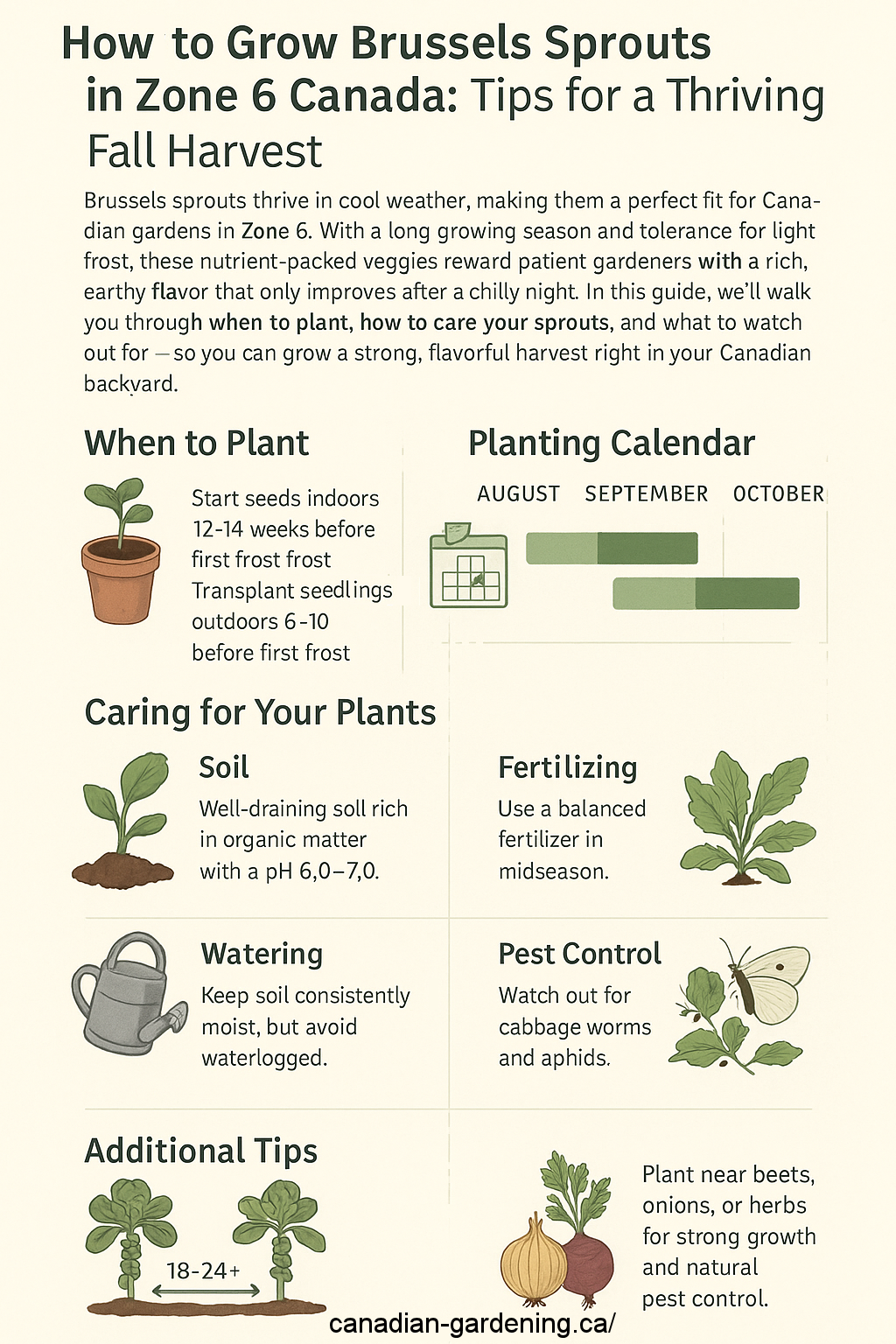Brussels Sprouts Growing

How I grow my Brussels Sprouts in Canada:
In this guide, I'll share everything I know — from starting seeds and transplanting to proper spacing, pest prevention and harvesting tips for flavorful harvest right in your Canadian backyard.
Brussels sprouts are a cold-loving vegetable that thrive in the cooler seasons, making them a great addition to any Canadian garden.
With their impressive nutritional value, these cold weather crop are well worth the patience they require to grow.
Tips for Growing Healthy Brussels Sprouts:
- Understanding Your Growing Zone:
Not sure what your growing zone is - check this Planting Zone Page and select your province.
Zone 6 in Canada typically experiences a last frost date around mid-May and a first frost date in late October.
This gives you a growing season of approximately 150 days—plenty of time to grow Brussels sprouts,
which take around 90-110 days to mature.
- When to Plant Brussels Sprouts in Zone 6:
• Start seeds indoors: Mid-March to early April.
• Transplant outdoors: Mid-May, after the last frost, usually around the end of May for me.
• Direct sowing (optional): Late April to early May, but indoor starting is preferred for stronger seedlings.
For the best flavor, aim to have your Brussels sprouts mature in the fall. Light frost improves their taste.
- Soil Preparation:
Brussels sprouts prefer:
• Soil type: Well-draining, loamy soil.
• pH level: Slightly acidic to neutral (6.5-7.0).
• Nutrients: Rich in organic matter; amend with compost or aged manure.
Before planting, work compost into the top 6-8 inches of soil to ensure strong root development.
- Spacing and Planting:
• Spacing: 18-24 inches between plants; 2-3 feet between rows.
• Depth: Plant transplants slightly deeper than they were in pots.
Firm the soil around the base to support their tall stalks as they grow.
- Care and Maintenance:
• Watering: 1-1.5 inches of water per week; consistent moisture and fertilizer is the key.
• Fertilizing: Use a balanced fertilizer (10-10-10) every 3-4 weeks or side-dress with compost.
• Mulching: Helps retain soil moisture and regulate temperature.
• Staking: Tall plants may need support in windy areas. Brussels Sprouts seem to bend wherever and staking keeps them from taking over the bed.
- Companion Planting - Brussels Sprouts:
• Beets
• Onions
• Carrots
Avoid planting with other brassicas or strawberries.
- Common Pests and Diseases:
• Cabbage worms & loopers: Use row covers early and hand-pick pests. Interplant Brussels Sprouts with Marigolds as a pest deterrent.
• Aphids: Spray with a strong stream of water or use insecticidal soap.
• Fungal issues: Avoid overhead watering and ensure good air circulation.
- Harvesting Brussels Sprouts:
• When to harvest: Sprouts are ready when they are firm, 1-2 inches in diameter.
• How to harvest: Start from the bottom of the stalk and twist or cut off each sprout.
Leave the top leaves intact until the final harvest to continue feeding the plant.
- Overwintering Tips (Optional):
In milder parts of Canada, Brussels sprouts can survive light snow. Use mulch around the base and row covers if early frosts arrive. In zone 6 Brussels Sprouts doesn't survive our winters. I wish it did. :)

How to Grow Brussels Sprouts from McKenzie Seed packet:
- Days to germination: 7-10 days
- Seed Depth: 1.3 cm (1/2")
- Seed Spacing: 1.3 cm (1/2")
- Plant Spacing: 45 cm (18")
- Row Spacing: 60 cm (24")
- Start seeds indoors 6-8 weeks before last frost date
Nutritional facts for Brussels Sprouts:
(based on 1 cup, cooked, boiled, drained - approximately 156g):
Brussels Sprouts (1 cup cooked)
- Calories: - 56
- Protein: - 4g
- Fat: - 0.8g
- Carbohydrates: - 11g
- Fiber: - 4g
- Sugars: - 2g
Vitamins & Minerals
- Vitamin K: 219 mcg (over 100% DV)
- Vitamin C: 97 mg (over 100% DV)
- Folate (B9): 94 mcg (24% DV)
- Vitamin A: 1050 IU (21% DV)
- Manganese: 0.3 mg (15% DV)
- Potassium: 494 mg (14% DV)
- Iron: 1.2 mg (7% DV)
Q & A
Q: - Where did Brussels Sprouts get its name?
A: - Brussels, Belgium.